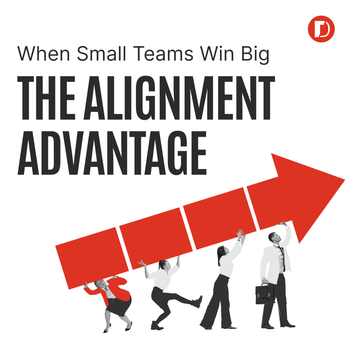8 Google Ads Automated Bidding Strategies and How to Use Them
by Ana Gotter • January 30, 2019
Automation is kind of the dream, right? It’s why services like Amazon’s subscription option are so popular, and why there are so many solutions rolling out daily to help us streamline everything from our meal planning to bill paying. We all have too many tasks and not enough hours in the day, after all, and perhaps no one knows this more than business owners and marketers.
Marketers and advertisers are all about efficiency, and the opportunity to streamline a campaign through automation sounds pretty appealing…especially if it has benefits like supposed automatic optimization or you’re managing an endless number of campaigns as is.
There are actually 8 different types of automated bidding strategies that you can choose from when it comes to Google Ads and each one prioritizes different results and actions. Some of these strategies can be great options for certain businesses or advertisers, but sometimes the automated campaigns come with big drawbacks.
In this post, we’re going to discuss each of the automated bidding strategies available in Google Ads and how to choose the strategy that’s right for each individual campaign you create.
What are Automated Bidding Strategies?
Automated bidding strategies allow you to hand the wheel over to Google, at least when it comes to what you’re bidding and what you’re bidding on. Instead of a manual bid, where you can set a specific limit for how much you’re willing to pay per click for any given click from a user who sees your ad, the automated strategies are going to be set by Google.
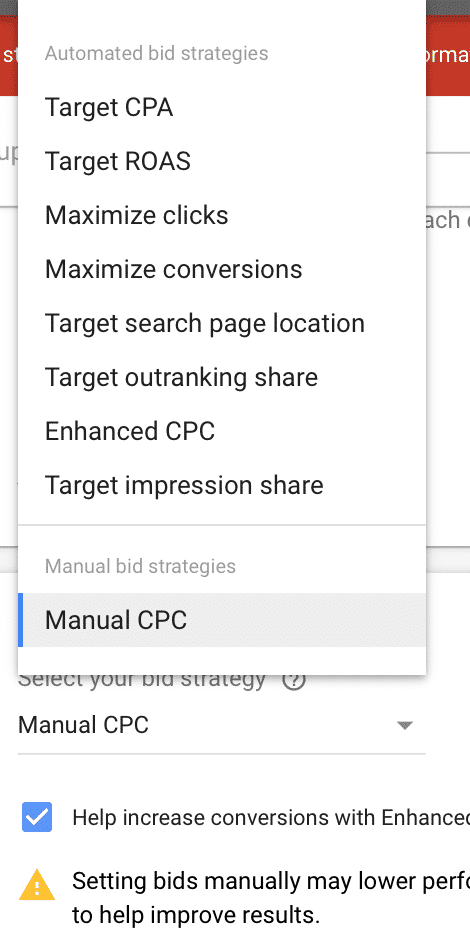
Their algorithms will automatically set bids based on the likelihood that your ad will get the click or conversion and they’ll calculate this information based largely on what they know about the specific user, including:
- The device they’re using
- Their demographics
- Location
- Time of day the search is made
- Their operating system
Automated bid strategies are goal-driven, meaning that they’re optimizing for a specific action, like clicks over conversions or vice versa. They’re designed to help advertisers who are worried about not bidding high enough, but by focusing in on likelihood of action, they also reduce the chance of spending too much on users who have absolutely zero intention of purchasing from you.
Automated bids are unique for each auction. They’re also updated as Google’s algorithm learns more over time based on user actions. That being said, they track changes over time, not immediately, so if there are any drastic changes in the marketplace, you’ll have to take over.
Some marketers prefer manual bidding because it gives them more control. They might know that they don’t want to spend more than $2.24 on a single click, ever. If this sounds like you, manual bidding is a good option. If not, though, keep reading to look at the different types of automated bidding strategies and see if they’re right for you.
Target CPA
The Target CPA bidding strategy focuses on driving as many conversions as possible at your target cost-per-acquisition (CPA). Though some bids will cost more or less than your target cost, they’ll average out to ensure that you’re staying where you need to overall.
This is one strategy that gives you some good control over your bidding, allowing you to set a specific target CPA.
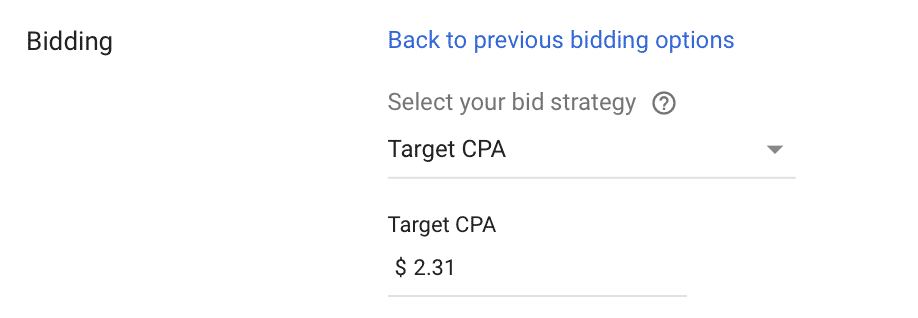
This bidding strategy can work well when you have an average CPA you want to stay near (but not necessarily under for every click you get). Before choosing this, have a good idea of what you can spend in order to maintain profitability when getting a sale, factoring in everything that can lead to a rise in costs or loss of ROI.
Some things to consider for this one:
- It requires conversion tracking to be enabled on your account. Check out how to install the pixel here.
- In order to get good results, it’s important to have some history of conversion data from Google Ads first, or this bidding strategy may not do you a ton of favors at first because it hasn’t “learned” yet. If you can, have at least 2o conversions within the past 30 days before using this strategy or know that the first two weeks could be a “learning” period.
Target ROAS
When using the Target ROAS strategy, you’re having Google set bids to maximize the conversion value as much as possible, maximizing your potential return on ad spend (ROAS). This bidding strategy can only be applied to a single campaign instead of multiple campaigns (which are also known as “portfolio” bidding strategies). This strategy is similar to target CPA, but the above allows you to use it as a portfolio bidding strategy and this focuses exclusively on ROAS while the other looks at the acquisition value outright.
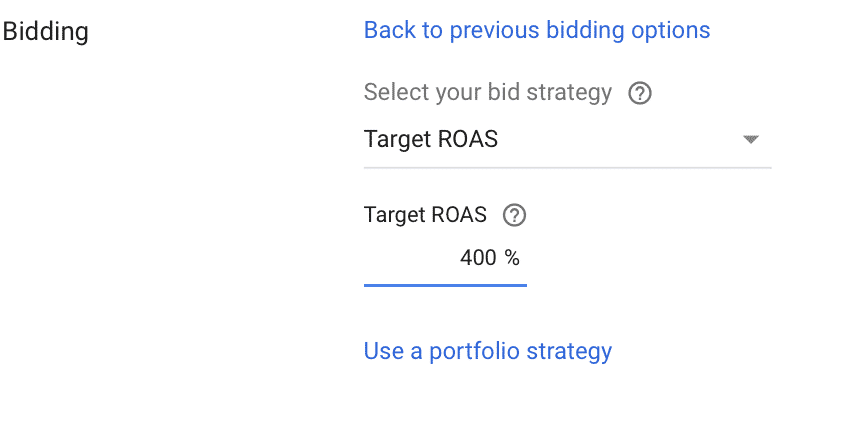
Your ROAS is the conversion value you’d like to get out of every dollar of ad spend you invest, telling you the return on ad spend you’re getting. If you want to make $4 in sales for every dollar spent on your ads, the ROAS would be 400%.
Here’s the catch, though. The conversion tracking concerns that apply to the Target CPA strategy apply here as well. There will be a learning curve, which can be expensive and frustrating to watch for a week or so.
Maximize Clicks
This bidding strategy is self-explanatory: it will work to get as many clicks on your ad as possible, going through your daily budget to make this happen. You can set a bid limit, which is nice as it ensures that you won’t end up blowing your budget on a few clicks, and this strategy can be used as a portfolio strategy.
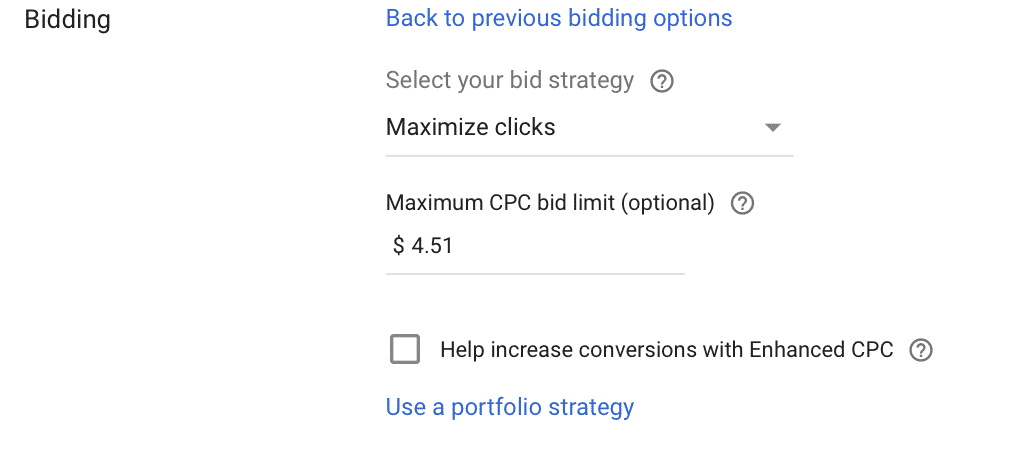
Here’s what you need to keep in mind with this conversion type:
- It’s almost always a good choice to set that bid limit so that Google doesn’t go through your budget in a way you won’t be happy with. Clicks are good, but not if they cost too much.
- This can be a good bidding option if you want to drive traffic to your site or a specific landing page.
- We recommend this most for audiences who currently have a strong conversion history on your campaigns and you want to step traffic up further.
- Google Ads will sometimes aggressively spend here to chew up your budget. They want to get you those clicks, but again, this can come at a cost, so keep the bid limits reasonable.
Maximize Conversions
Maximize conversions is going to be similar to the above bidding strategy, but the focus here will be entirely on getting conversions instead of just clicks. Google will go through your budget quickly to get you those conversions whenever possible.

You’ll notice, however, that unlike the above bidding strategy, this one doesn’t let you set a bid cap. Here’s what you need to know:
- The inability to set a bid cap is a hard hit for advertisers. There’s a huge risk that Google can burn through your ad spend with too-high CPCs that get you some results, but not at a price that’s profitable.
- Conversion tracking must be enabled for the algorithm to be able to correctly optimize for conversions.
This bidding strategy is typically not one I’d recommend, because while it can yield a lot of actions, it does so at the discretion of a huge financial risk.
Target Search Page Location
This bidding strategy prioritizes ad placement, letting advertisers bid on either the top of the search page or on the first page of results. You get to pick which location you want to prioritize. This is a portfolio-only bidding strategy, which means it can be applied to multiple campaigns.
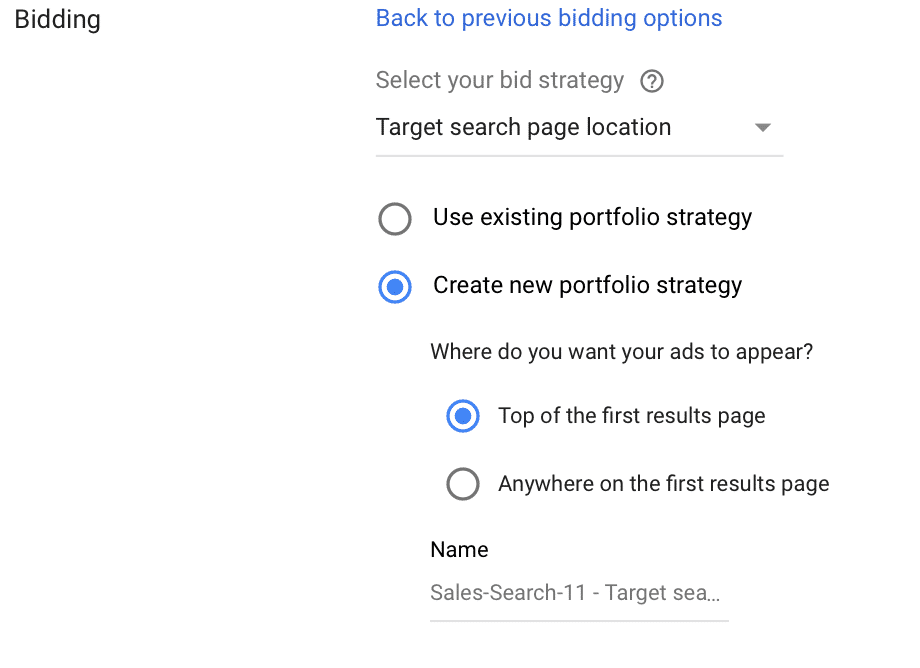
Here’s what you should keep in mind when choosing this bidding strategy:
- The ability to have your ad show up in the right place is an advantage, especially in searches for high-value but very competitive keywords where ad rank can be crucial.
- The idea behind this bidding strategy is that Google will automatically up your bid when necessary to get those high-visibility results. Make sure that this is worth it before you choose it, and if so, keep a close eye on those CPCs.
- Remember that the higher your ad location and ad rank, the higher your CPC or CPA may become. Again, watch your CPCs because high ad placements are no longer worth it if you literally can’t afford them.
Target Outranking Share
Keeping up with the pattern we already have going, this bidding strategy is similar to the one directly above it because it focuses on the placement of the ad instead of the value or cost of a certain action. This strategy, however, prioritizes not just good placements but actually outranking very specific competitors.
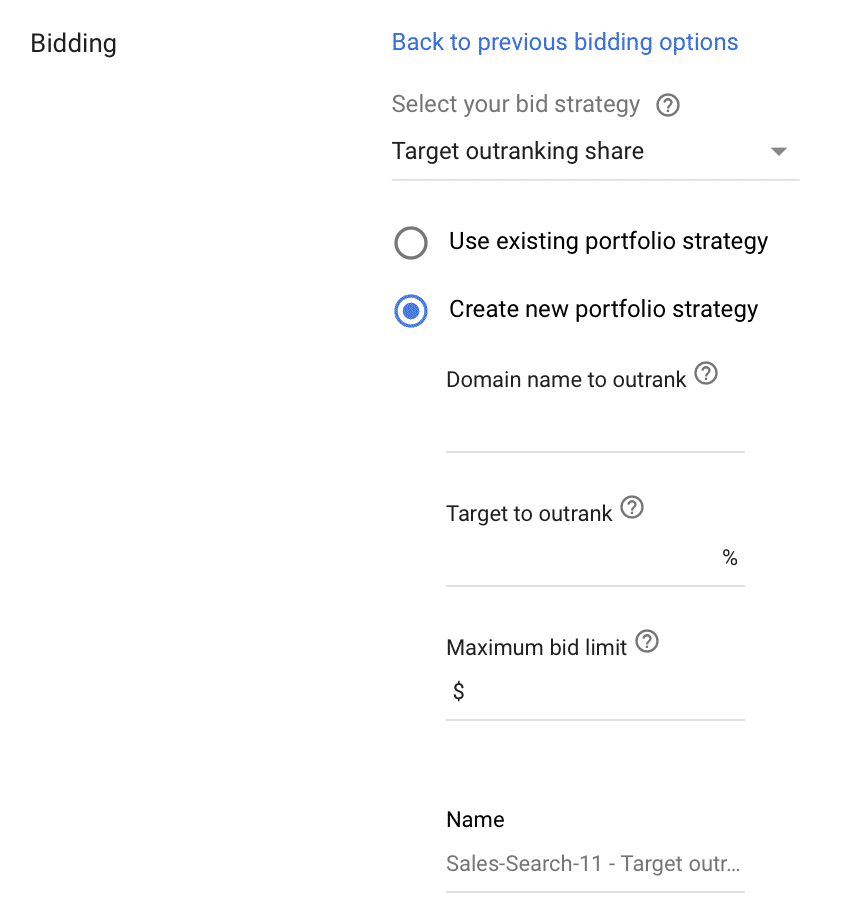
Let’s say you are a small shoe company and you’re sick of Nike dominating the traffic. You can enter in their domain name as the one you want to outrank, and hopefully take control of that first-place ad result for “running shoes” and “cross trainers.”
These are the highlights for this campaign:
- There’s the option to set a bid limit. Do this. Big names have big budgets, and you don’t want to go broke trying to keep up.
- You can try to outrank specific competitors who are continually stealing some of those high-value keywords. If you can afford to watch your CPCs increase so that you can snag some of those sales, full steam ahead.
Enhanced CPC
Enhanced CPC can be applied on its own, but it can also be applied to other bidding strategies, too. It stands for “enhanced cost-per-click,” and while it’s similar to manual bidding, it allows Google to adjust your bid—even if you’ve set it manually. Google will adjust the bid depending on the likelihood for a sale, increasing it if the likelihood is higher and decreasing it if lower.

Here’s the information you need about the strategy:
- It does have a history of helping to boost click-through rates (CTR) and conversion rates, but it often comes at the cost of a higher CPC.
- This limits the ability to set proper bid caps, allowing Google to make the final decision. This can result in major loss in profitability, which isn’t a risk most businesses want to take.
Target Impression Share
This is a relatively new bidding strategy that prioritizes bidding to reach a target percentage of the impression share.
Impression share tells you what percentage of searches you’re appearing in that you were capable of showing up in based on targeting and keywords. Sometimes a low impression share is at least partially the result of low bids and this strategy can help you combat that. The higher the impression share, the more people are seeing your ad and the more chances you have at a click or conversion.
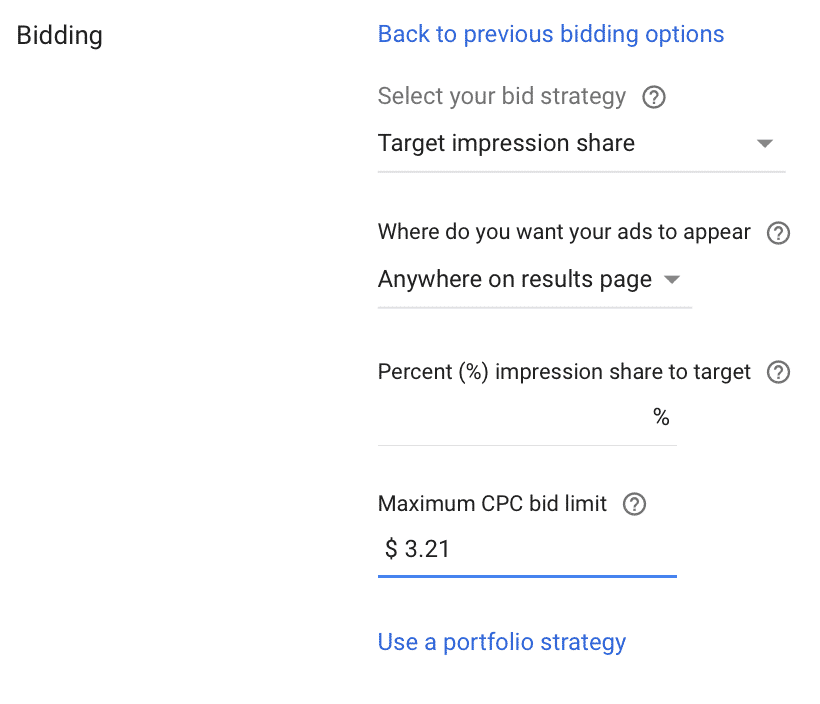
Here’s what you need to know about this bidding strategy:
- The ability to set a maximum CPC is, once again, valuable. Use it, because you don’t need to chew up your entire budget to simply get more impressions that may not even convert.
- You can prioritize for different page locations, including Top of the Page and Anywhere on the Page, allowing you to decide if you only want to bid on impressions at the very top of visibility.
- Impression share simply means having your ad show up more often. That’s all it’s optimizing for, not specific actions.
Should I Use Automated Bidding Strategies?
The idea of automation is alluring for sure, but most advertisers are still preferring to opt for manual bidding instead. There are a few reasons for this, including:
- It lets them increase bids on specific terms or ad groups that are particularly high value, and thus increasing the likelihood of improving ad rank (and results) for those ads.
- It prevents their CPC from running away from them and squashing their chance at profitability. Who cares if you’re getting conversions, after all, if your’e doing it at $15 a click and you can only afford to spend $10?

Automated bidding strategies can be useful in some circumstances, but in many cases you’ll benefit most from sticking with manual bidding and making sure that your campaigns are optimized in other ways and with strong, high-value and high-intent keywords.
Conclusion
While many advertising agencies prefer to be as in-control of the bids as possible (and thus typically opt for manual bidding on the majority of the campaigns they run), there is a time and place for certain automated bidding strategies. They can save you time and help you optimize your campaigns for certain results, which is a good thing at face value.
Just make sure that the time saved is worth whatever sacrifice you could be making when you give up control in the form of a manual bid, and to keep a particularly close eye on those campaigns.
Struggling to choose the bidding strategy that’s right for you? We can help you manage all aspects of your PPC campaigns, all the way down to the bidding strategies (automated or not). Get in touch to see how we can help.
What do you think? How do you feel about automated bidding strategies? Do you prefer automation over manual bidding? Why or why not? Share your thoughts, knowledge, and questions in the comments section below!



